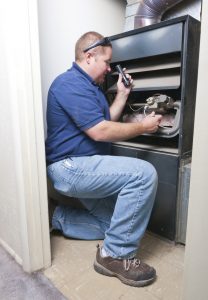 When a problem comes up with a newer furnace, there are a few things you can probably pin the issue on. Unfortunately, new furnaces often run into problems because they were not properly installed. Incorrect sizing or sloppy installation lead to long-term and short-term issues within the system, likely causing an early breakdown. However, most problems with a newer furnace have to do with a smaller issue, like a small wiring issue or even a dirty filter.
When a problem comes up with a newer furnace, there are a few things you can probably pin the issue on. Unfortunately, new furnaces often run into problems because they were not properly installed. Incorrect sizing or sloppy installation lead to long-term and short-term issues within the system, likely causing an early breakdown. However, most problems with a newer furnace have to do with a smaller issue, like a small wiring issue or even a dirty filter.
But older furnaces are a different story. Problems that come up with an older furnace are often the result of a long history of wear and tear on the system, and the issues can be complex. That’s why you should always contact qualified technicians when you need furnace repair! For guidance on whether to repair or replace an older heating system, read our article on repairing or replacing your boiler system.
Replacing Ignition Switches
Throughout this guide, you’ll see a pattern. When older furnaces break down, there’s often no simple fix or tune-up that can solve the problem. You will likely need to replace a component, such as the ignition switch that starts up the furnace in the first place.
Today’s gas furnaces use electronic ignition, an improvement over older standing gas pilots that wasted a lot of energy. There are many benefits to using hot surface ignition or an electronic start to start the furnace cycle and light the burners—except that the ignition switch may eventually wear out and need replacement.
Replacing Thermocouples and Flame Sensors
The thermocouple and flame sensor essentially do the same job. The difference is that a thermocouple is installed in older standing gas pilot systems, to detect whether a standing flame is present, while a flame sensor works in newer furnaces.
If the thermocouple or flame sensor does not detect a flame, it will shut off the gas valve for your safety. It is possible, however, that there is indeed a flame, but the thermocouple or flame sensor does not properly detect it. In this case, it must either be cleaned or replaced.
Replacing a Bad Relay
When a furnace starts up, it doesn’t start blowing air into your home right away. You have to wait a couple of minutes, at most, for the furnace plenum to get warm. Only at this point does the blower fan activate, as the relay ensures the blower only brings warm air into the home.
If the relay is broken, however, the fan may not start up at all. Thankfully, the limit switch within the system will shut off the furnace before it overheats, but you will need to replace this component.
Repairing or Replacing Fan Motors
The fan motor is the one part of your furnace used by both the heater and air conditioner, so it’s gotten quite the workout over the years. It’s no wonder this part often needs replacement in older furnaces. Sometimes, though, it only needs a fan belt adjusted or a bit of lubrication to continue to run smoothly. If strange noises accompany these issues, explore what furnace sounds might mean to determine if repairs are needed.
When to Replace the Entire System
Of course, there will eventually come a time when you’ll have to replace the entire heating system. If you find this out, keep in mind that a repair would likely not be worth the cost if it’s only going to patch up a system that’s doomed to fail anyway. A new system will run effectively and efficiently, and you’re likely to notice a difference in your comfort levels right away! For tips before you schedule your heating repair or replacement, check out our guide on preparing for heating repair.
Schedule your next heating repair in Whitehall, PA with Boehmer Heating & Cooling today!

